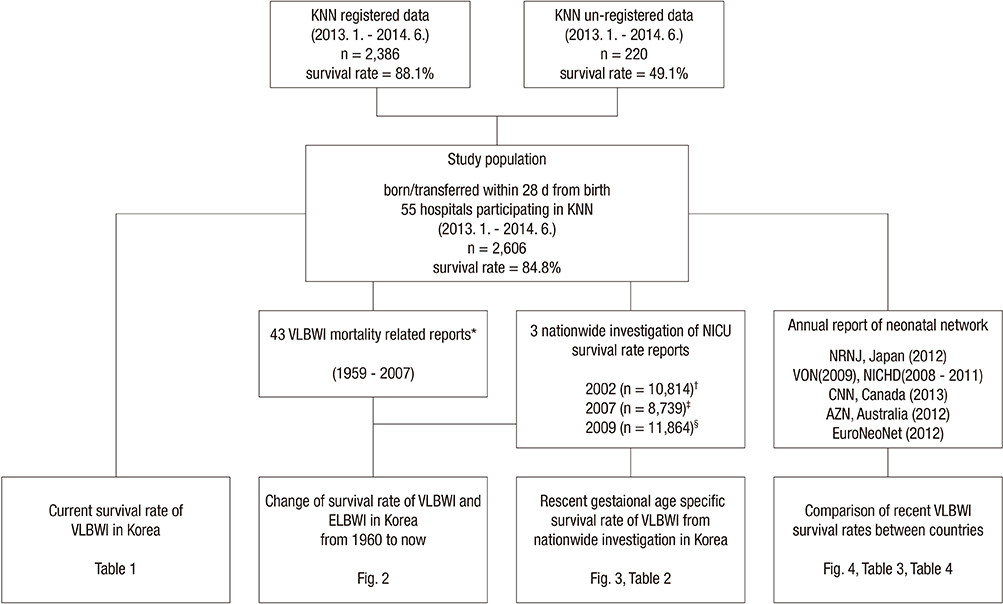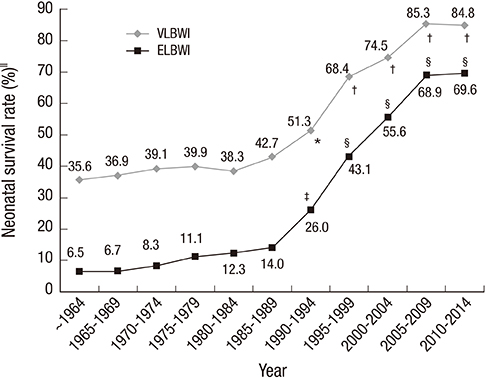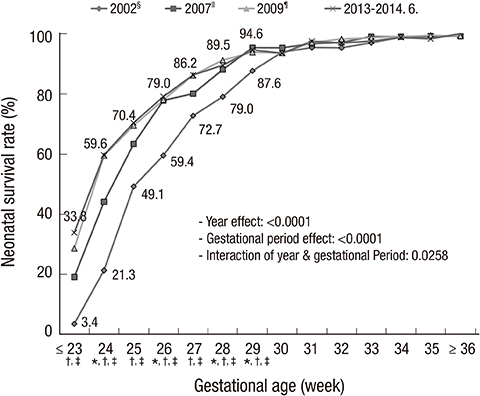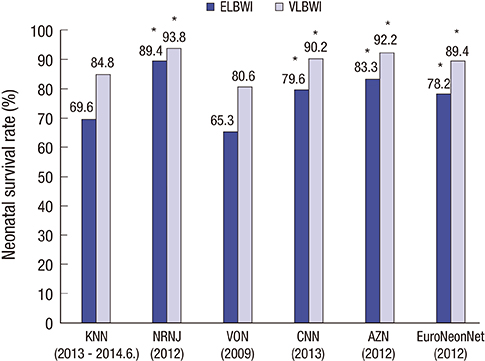Changes in Survival Rate for Very-Low-Birth-Weight Infants in Korea: Comparison with Other Countries
- Affiliations
-
- 1Department of Pediatrics, Kangbuk Samsung Hospital, Sungkyunkwan University School of Medicine, Seoul, Korea.
- 2Department of Pediatrics, Gangneung Asan Hospital, University of Ulsan College of Medicine, Gangneung, Korea.
- 3Department of Pediatrics, Kyung Hee University School of Medicine, Seoul, Korea. baecw@khnmc.or.kr
- KMID: 2351133
- DOI: http://doi.org/10.3346/jkms.2015.30.S1.S25
Abstract
- Recently the Korean Neonatal Network (KNN) was established in order to enhance treatment outcomes further through the registration of very-low-birth-weight infants (VLBWI) data. The present study was conducted on 2,606 VLBWI, 2,386 registered and 220 un-registered, in the KNN participating centers, with the objective of reporting on recent survival rates of VLBWI in Korea and verifying the changing trends in survival rates with data from the 1960s and beyond. The study also aimed to compare the premature infants' survival rate in Korea with those reported in neonatal networks of other countries. The recent survival rate of VLBWI increased more than twice from 35.6% in the 1960s to 84.8%, and the survival rate of the extremely low birth weight infants (ELBWI) increased by more than 10 times, indicating improvement of the survival rate in premature infants with lower birth weight and gestational age. Comparison of VLBWI between countries showed improved survival rates according to each birth weight group in Canada, Australia-New Zealand, and European countries with Japan at the head, but in terms of comparison based on gestational age, differences, except for Japan, have been reduced. Efforts to increase the survival rate of premature infants in Korea with low birth rate are inevitable, and they should be the foundation of academic and clinical development based on its network with advanced countries.
Keyword
MeSH Terms
Figure
Cited by 11 articles
-
Pulmonary Surfactant Replacement Therapy for Respiratory Distress Syndrome in Neonates: a Nationwide Epidemiological Study in Korea
Jeong Eun Shin, So Jin Yoon, Joohee Lim, Jungho Han, Ho Seon Eun, Min Soo Park, Kook In Park, Soon Min Lee
J Korean Med Sci. 2020;35(32):e253. doi: 10.3346/jkms.2020.35.e253.Neonatal Outcomes according to the Latent Period from Membrane Rupture to Delivery among Extremely Preterm Infants Exposed to Preterm Premature Rupture of Membrane: a Nationwide Cohort Study
Jae Hyun Park, Jin Gon Bae, Yun Sil Chang
J Korean Med Sci. 2021;36(14):e93. doi: 10.3346/jkms.2021.36.e93.The Youngest Survivor with Gestational Age of 215/7 Weeks
Se In Sung, So Yoon Ahn, Hye Soo Yoo, Yun Sil Chang, Won Soon Park
J Korean Med Sci. 2018;33(3):. doi: 10.3346/jkms.2018.33.e22.Comparison of Acute Abdominal Surgical Outcomes of Extremely-Low-Birth-Weight Neonates according to Differential Diagnosis
Jeik Byun, Hyun-Young Kim, Sung-Eun Jung, Hee-Beom Yang, Ee-Kyung Kim, Seung Han Shin, Han-Suk Kim
J Korean Med Sci. 2019;34(35):. doi: 10.3346/jkms.2019.34.e222.Neonatal Outcomes of Very Low Birth Weight Infants in Korean Neonatal Network from 2013 to 2016
Jang Hoon Lee, O Kyu Noh, Yun Sil Chang,
J Korean Med Sci. 2019;34(5):. doi: 10.3346/jkms.2019.34.e40.History of Pulmonary Surfactant Replacement Therapy for Neonatal Respiratory Distress Syndrome in Korea
Chong-Woo Bae, Chae Young Kim, Sung-Hoon Chung, Yong-Sung Choi
J Korean Med Sci. 2019;34(25):. doi: 10.3346/jkms.2019.34.e175.Past, present, and future of neonatology in Korea
Yun Sil Chang
J Korean Med Assoc. 2016;59(7):487-489. doi: 10.5124/jkma.2016.59.7.487.The history of neonatology in Korea
Chong-Woo Bae
J Korean Med Assoc. 2016;59(7):490-497. doi: 10.5124/jkma.2016.59.7.490.Survival and Morbidities in Infants with Birth Weight Less than 500 g: a Nationwide Cohort Study
Ji Hye Hwang, Euiseok Jung, Byong Sop Lee, Ellen Ai-Rhan Kim, Ki-Soo Kim
J Korean Med Sci. 2021;36(31):e206. doi: 10.3346/jkms.2021.36.e206.Cognitive and Behavioral Outcomes of School-aged Children Born Extremely Preterm: a Korean Single-center Study with Long-term Follow-up
Eun Sun Kim, Ee-Kyung Kim, Sae Yun Kim, In Gyu Song, Young Hwa Jung, Seung Han Shin, Han-Suk Kim, Johanna Inhyang Kim, Bung Nyun Kim, Min-Sup Shin
J Korean Med Sci. 2021;36(39):e260. doi: 10.3346/jkms.2021.36.e260.Serial Short-Term Outcomes of Very-Low-Birth-Weight Infants in the Korean Neonatal Network From 2013 to 2020
Ga Won Jeon, Jang Hoon Lee, Minkyung Oh, Yun Sil Chang
J Korean Med Sci. 2022;37(29):e229. doi: 10.3346/jkms.2022.37.e229.
Reference
-
1. Patel RM, Kandefer S, Walsh MC, Bell EF, Carlo WA, Laptook AR, Sánchez PJ, Shankaran S, Van Meurs KP, Ball MB, et al. Kennedy Shriver National Institute of Child Health and Human Development Neonatal Research Network. Eunice Kennedy Shriver National Institute of Child Health and Human Development Neonatal Research Network. Causes and timing of death in extremely premature infants from 2000 through 2011. N Engl J Med. 2015; 372:331–340.2. Ancel PY, Goffinet F, Kuhn P, Langer B, Matis J, Hernandorena X, Chabanier P, Joly-Pedespan L, Lecomte B, Vendittelli F, et al. EPIPAGE-2 Writing Group. EPIPAGE-2 Writing Group. Survival and morbidity of preterm children born at 22 through 34 weeks' gestation in France in 2011: results of the EPIPAGE-2 cohort study. JAMA Pediatr. 2015; 169:230–238.3. Stoll BJ, Hansen NI, Bell EF, Shankaran S, Laptook AR, Walsh MC, Hale EC, Newman NS, Schibler K, Carlo WA, et al. Kennedy Shriver National Institute of Child Health and Human Development Neonatal Research Network. Eunice Kennedy Shriver National Institute of Child Health and Human Development Neonatal Research Network. Neonatal outcomes of extremely preterm infants from the NICHD Neonatal Research Network. Pediatrics. 2010; 126:443–456.4. Agarwal P, Sriram B, Rajadurai VS. Neonatal outcome of extremely preterm Asian infants ≤28 weeks over a decade in the new millennium. J Perinatol. 2015; 35:297–303.5. Park DK, Kil CH, Bae CW. Neonatal statistics of Korea in 2002: collective results of live-births, and neonatal mortality rates from 62 hospitals. J Korean Soc Neonatol. 2004; 11:122–129.6. Hahn WH, Chang JY, Bae CW. Birth statistics and mortality rates for neonatal intensive care units in Korea during 2007: collective results from 57 hospitals. J Korean Soc Neonatol. 2009; 16:36–47.7. Hahn WH, Chang JY, Chang YS, Shim KS, Bae CW. Recent trends in neonatal mortality in very low birth weight Korean infants: in comparison with Japan and the USA. J Korean Med Sci. 2011; 26:467–473.8. Korean Statistical Information Service. Birth statistics. accessed on 20 April 2015. Available at http://www.kosis.kr/.9. Moon JY, Hahn WH, Shim KS, Chang JY, Bae CW. Changes of maternal age distribution in live births and incidence of low birth weight infants in advanced maternal age group in Korea. Korean J Perinatol. 2011; 22:30–36.10. Choi SH, Park YS, Shim KS, Choi YS, Chang JY, Hahn WH, Bae CW. Recent trends in the incidence of multiple births and its consequences on perinatal problems in Korea. J Korean Med Sci. 2010; 25:1191–1196.11. Horbar JD, Carpenter JH, Badger GJ, Kenny MJ, Soll RF, Morrow KA, Buzas JS. Mortality and neonatal morbidity among infants 501 to 1500 grams from 2000 to 2009. Pediatrics. 2012; 129:1019–1026.12. Kim TH, Choi MS, Chung SH, Choi YS, Bae CW. Morbidity of low birth weight infants in Korea (2012): a comparison with Japan and the USA. Neonatal Med. 2014; 21:218–223.13. Shah PS, Lee SK, Lui K, Sjörs G, Mori R, Reichman B, Håkansson S, Feliciano LS, Modi N, Adams M, et al. International Network for Evaluating Outcomes of Neonates (iNeo). The international network for evaluating outcomes of very low birth weight, very preterm neonates (iNeo): a protocol for collaborative comparisons of international health services for quality improvement in neonatal care. BMC Pediatr. 2014; 14:110.14. Kramer MS, Platt RW, Yang H, Haglund B, Cnattingius S, Bergsjo P. Registration artifacts in international comparisons of infant mortality. Paediatr Perinat Epidemiol. 2002; 16:16–22.15. Isayama T, Lee SK, Mori R, Kusuda S, Fujimura M, Ye XY, Shah PS. Canadian Neonatal Network. Neonatal Research Network of Japan. Canadian Neonatal Network; Neonatal Research Network of Japan. Comparison of mortality and morbidity of very low birth weight infants between Canada and Japan. Pediatrics. 2012; 130:e957–e965.16. Chang YS, Ahn SY, Park WS. The establishment of the Korean Neonatal Network (KNN). Neonatal Med. 2013; 20:169–178.17. Kim KS, Bae CW. Trends in survival rate for very low birth weight infants and extremely low birth weight infants in Korea, 1967-2007. Korean J Pediatr. 2008; 51:237–242.18. Kim DH, Shim SY, Kim JR, Shin SH, Kim ES, Joung KE, Kim SD, Lee JA, Choi CW, Kim EK, et al. Recent outcome of extremely low birth weight infants: the use of CRIB(clinical risk index for babies) II score for analyzing the survival rate. Korean J Pediatr. 2006; 49:952–958.19. Egger M, Smith GD. Meta-analysis. Potentials and promise. BMJ. 1997; 315:1371–1374.20. Neonatal Research Network Japan. accessed on 20 April 2015. Available at http://nrn.shiga-med.ac.jp/Englishdefault.htm.21. The Canadian Neonatal Network TM. accessed on 20 April 2015. Available at http://www.canadianneonatalnetwork.org/portal/.22. Australian & New Zealand Neonatal Network (ANZNN). National Perinatal Epidemiology and Statistics Unit (NPESU). accessed on 20 April 2015. Available at https://npesu.unsw.edu.au/data-collection/australian-new-zealand-neonatal-network-anznn.23. European Neonatal Network. EuroNeoNet. accessed on 20 April 2015. Available at http://www.euroneonet.eu/paginas/publicas/euroneo/euroNeoNet/index.html.24. Hanley JA, Negassa A, Edwardes MD, Forrester JE. Statistical analysis of correlated data using generalized estimating equations: an orientation. Am J Epidemiol. 2003; 157:364–375.25. Hubbard AE, Ahern J, Fleischer NL, Van der Laan M, Lippman SA, Jewell N, Bruckner T, Satariano WA. To GEE or not to GEE: comparing population average and mixed models for estimating the associations between neighborhood risk factors and health. Epidemiology. 2010; 21:467–474.26. Shah PS, Sankaran K, Aziz K, Allen AC, Seshia M, Ohlsson A, Lee SK. Canadian Neonatal Network. Outcomes of preterm infants <29 weeks gestation over 10-year period in Canada: a cause for concern? J Perinatol. 2012; 32:132–138.27. Evans TA, Seaton SE, Manktelow BN. Quantifying the potential bias when directly comparing standardised mortality ratios for in-unit neonatal mortality. PLoS One. 2013; 8:e61237.28. Draper ES, Field DJ. Epidemiology of prematurity--how valid are comparisons of neonatal outcomes. Semin Fetal Neonatal Med. 2007; 12:337–343.29. Terzic S, Heljic S. Assessing mortality risk in very low birth weight infants. Med Arh. 2012; 66:76–79.30. Bae YM, Bae CW. The changes in the mortality rates of low birth weight infant and very low birth weight infant in Korea over the past 40 years. J Korean Med Sci. 2004; 19:27–31.31. Choi JH. Milestones of the History of Neonatal Intensive Care in Korea. Neonatal Med. 2013; 20:236–248.32. Kusuda S, Fujimura M, Uchiyama A, Totsu S, Matsunami K. Research Network Japan. Trends in morbidity and mortality among very-low-birth-weight infants from 2003 to 2008 in Japan. Pediatr Res. 2012; 72:531–538.33. Su BH, Hsieh WS, Hsu CH, Chang JH, Lien R, Lin CH. Baby Foundation of Taiwan (PBFT). Neonatal outcomes of extremely preterm infants from taiwan: comparison with Canada, Japan, and the USA. Pediatr Neonatol. 2015; 56:46–52.34. Kusuda S, Fujimura M, Sakuma I, Aotani H, Kabe K, Itani Y, Ichiba H, Matsunami K, Nishida H, Neonatal Research. Morbidity and mortality of infants with very low birth weight in Japan: center variation. Pediatrics. 2006; 118:e1130–e1138.35. Shim JW, Kim MJ, Kim EK, Park HK, Song ES, Lee SM, Lee JH, Jin HS, Kim ES, Chang YS, et al. The impact of neonatal care resources on regional variation in neonatal mortality among very low birthweight infants in Korea. Paediatr Perinat Epidemiol. 2013; 27:216–225.36. Arnold C, Tyson JE. Outcomes following periviable birth. Semin Perinatol. 2014; 38:2–11.37. Upadhyay RP, Krishnan A, Rai SK, Chinnakali P, Odukoya O. Need to focus beyond the medical causes: a systematic review of the social factors affecting neonatal deaths. Paediatr Perinat Epidemiol. 2014; 28:127–137.38. Rossen LM, Schoendorf KC. Trends in racial and ethnic disparities in infant mortality rates in the United States, 1989-2006. Am J Public Health. 2014; 104:1549–1556.39. Goldstein RF, Cotten CM, Shankaran S, Gantz MG, Poole WK. Eunice Kennedy Shriver National Institute of Child Health and Human Development Neonatal Research Network. Influence of gestational age on death and neurodevelopmental outcome in premature infants with severe intracranial hemorrhage. J Perinatol. 2013; 33:25–32.40. Ishii N, Kono Y, Yonemoto N, Kusuda S, Fujimura M, Neonatal Research. Outcomes of infants born at 22 and 23 weeks' gestation. Pediatrics. 2013; 132:62–71.
- Full Text Links
- Actions
-
Cited
- CITED
-
- Close
- Share
- Similar articles
-
- The low birth weight rate in Korea
- Trends in survival rate for very low birth weight infants and extremely low birth weight infants in Korea, 1967-2007
- Changes in neonatal outcomes in Korea
- Clinical Study of Prematurity and Low Birth Weight Infants
- Changes in birth rates of low birth weight and premature infants in Korea over the past 7 years





